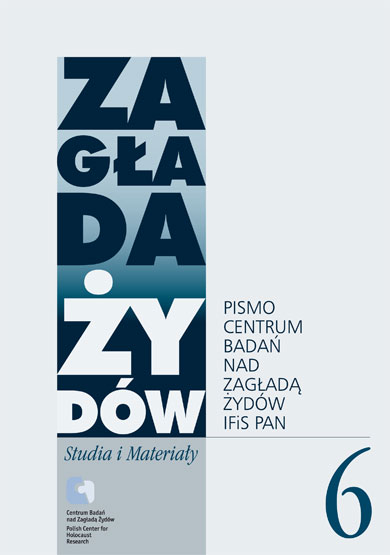Lagry w perspektywie genderowej
Zagłada Żydów. Studia i Materiały, Nr 6 (2010), Strony: 193-204
Data zgłoszenia: 2020-12-06Data publikacji: 2010-12-30
 https://doi.org/10.32927/zzsim.716
https://doi.org/10.32927/zzsim.716
Abstrakt
The questions of corporality, sexuality, women’s experience and their record examined in the context of camp issues and the Holocaust have only recently become the subject of attention. Gender studies play a significant role in the discussion on those issues. Existing works on the subject (i.a. the book of Bożena Karwowska Ciało. Seksualność. Obozy zagłady [Gender, Sexuality, Concentration Camps]) show that the tools of gender studies are cognitively useful, but, as it appears, their role of being particularly predestined to uncover what is marginalized or condemned to silence is overestimated. Nevertheless, apart from the dominance of the patriarchal discourse, there have always existed other reasons for suppressing the matter of corporality and sexuality both in works on KL’s and in science; social taboo (controlled not only by the male symbolical order) as well as the policy (e.g. it was possible to
write openly about rape on former female prisoners by Soviet soldiers only after censorship had been lifted) play an important role here. The fundamental value of the gender perspective lies in the firm approach towards the issues hitherto marginalized in the KL context – both by science and, to a lesser extent, literature (which is reflected by i.a. works of Pankowski and Posmysz published years ago).
Licencja
Prawa autorskie (c) 2010 Autor & "Zagłada Żydów. Studia i Materiały"

Utwór dostępny jest na licencji Creative Commons Uznanie autorstwa 4.0 Międzynarodowe.
https://creativecommons.org/licenses/by/4.0
Podobne artykuły
- Zofia Wóycicka, U „kresu pewnej moralności”: dyskusje wokół procesów więźniów funkcyjnych w Polsce 1945–1950 , Zagłada Żydów. Studia i Materiały: Nr 3 (2007)
- Anka Grupińska, Dariusz Libionka, Rozmowa z Józefem Grynblattem, członkiem Betaru i Żydowskiego Związku Wojskowego w czasie powstania w getcie warszawskim , Zagłada Żydów. Studia i Materiały: Nr 3 (2007)
- Israel Gutman, Artur Eisenbach: historyk i pracownik Żydowskiego Instytutu Historycznego , Zagłada Żydów. Studia i Materiały: Nr 3 (2007)
- Jan Grabowski, Przegląd dyskusji o kolaboracji na łamach „Slavic Review” 2005, t. 4 (64) , Zagłada Żydów. Studia i Materiały: Nr 2 (2006)
- Małgorzata Melchior, TEC Nechama, Resilience and Courage. Women, Men, and the Holocaust , Zagłada Żydów. Studia i Materiały: Nr 2 (2006)
- Sławomir Buryła, Kertzer David, Papieże a Żydzi , Zagłada Żydów. Studia i Materiały: Nr 2 (2006)
- Klaus Peter Friedrich, Nazistowski mord na Żydach w prasie polskich komunistów (1942–1944). , Zagłada Żydów. Studia i Materiały: Nr 2 (2006)
- Andrzej Grzegorczyk, Procedura i przebieg transportów kolejowych z getta łódzkiego do obozu zagłady w Chełmnie nad Nerem (styczeń–maj 1942 r.) , Zagłada Żydów. Studia i Materiały: Nr 16 (2020)
- Aleksandra Kasznik-Christian, Sprawa Marty Puretz, domniemanej agentki Gestapo z krakowskiego getta , Zagłada Żydów. Studia i Materiały: Nr 16 (2020)
- [Łucja Pawlicka-Nowak], Monika Polit, Relacja Mordechaja Żurawskiego z Chełmna nad Nerem [oprac. [Łucja Pawlicka-Nowak], Monika Polit, tłum. Monika Polit, Anna Styczyńska, Miłosz Omietoński] , Zagłada Żydów. Studia i Materiały: Nr 16 (2020)
<< < 1 2 3 4 5 6 7 8 9 10 11 12 13 14 15 16 17 18 19 20 21 22 23 > >>
Możesz również Rozpocznij zaawansowane wyszukiwanie podobieństw dla tego artykułu.
 English
English
 Język Polski
Język Polski








